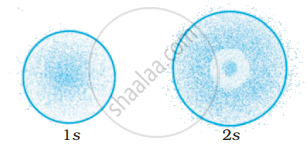Advertisements
Advertisements
प्रश्न
Explain in brief, the significance of the azimuthal quantum number.
उत्तर
- Azimuthal quantum number is also known as the subsidiary quantum number and is represented by the letter l.
- It represents the subshell to which the electron belongs. It also defines the shape of the orbital that is occupied by the electron.
- Its value depends upon the value of principal quantum number ‘n’. It can have only positive values between 0 and (n − 1).
- Atomic orbitals with the same value of ‘n’ but different values of ‘l’ constitute a subshell belonging to the shell for the given ‘n’. The azimuthal quantum number gives the number of subshells in a principal shell. The subshells have l to be 0, 1, 2, 3 … which are represented by symbols s, p, d, f, … respectively.
Principal shell Value of n Permissible value of l Possible subshell Number of subshells in shell K 1 0 s 1 L 2 0, 1 s, p 2 M 3 0, 1, 2 s, p, d 3 N 4 0, 1, 2, 3 s, p, d, f 4
APPEARS IN
संबंधित प्रश्न
Using s, p, d notations, describe the orbital with the following quantum numbers n = 1, l = 0.
Using s, p, d notations, describe the orbital with the following quantum numbers n = 3; l =1.
Choose the correct option.
p-orbitals are _________ in shape.
Choose the correct option.
“No two electrons in the same atoms can have identical set of four quantum numbers”. This statement is known as -
Give the names of quantum numbers.
Explain the anomalous behaviour of copper.
Write condensed orbital notation of electronic configuration of the following element:
Oxygen (Z = 8)
Draw shapes of 2s orbitals.
Draw shapes of 2p orbitals.
If n = 3, what are the quantum number l and m?
Indicate the number of unpaired electron in:
Cr (Z = 24)
How many electrons in 19K have n = 3, l = 1?
The three electrons have the following set of quantum numbers:
X = 6, 1, −1, `+1/2`
Y = 6, 0, 0, `+1/2`
Z = 5, 1, 0, `+1/2`
Identify the CORRECT statement.
Which of the following has a greater number of electrons than neutrons?
(Mass number of Mg, C, O and Na is 24, 12, 16 and 23 respectively).
The probability density plots of 1s and 2s orbitals are given in Figure:

The density of dots in a region represents the probability density of finding electrons in the region.
On the basis of above diagram which of the following statements is incorrect?
Which of the following properties of atom could be explained correctly by Thomson Model of atom?
Which of the following sets of quantum numbers are correct?
| `n` | `l` | `m_l` | |
| (i) | 1 | 1 | +2 |
| (ii) | 2 | 1 | +1 |
| (iii) | 3 | 2 | –2 |
| (iv) | 3 | 4 | –2 |
Which of the following statements concerning the quantum numbers are correct?
(i) Angular quantum number determines the three dimensional shape of the orbital.
(ii) The principal quantum number determines the orientation and energy of the orbital.
(iii) Magnetic quantum number determines the size of the orbital.
(iv) Spin quantum number of an electron determines the orientation of the spin of electron relative to the chosen axis.
Which of the following orbitals are degenerate?
3dxy, 4dxy 3dz2, 3dyz, 4dyz, 4dz2
The arrangement of orbitals on the basis of energy is based upon their (n + l) value. Lower the value of (n + l), lower is the energy. For orbitals having same values of (n + l), the orbital with lower value of n will have lower energy.
Based upon the above information, arrange the following orbitals in the increasing order of energy.
5p, 4d, 5d, 4f, 6s
What is the difference between the terms orbit and orbital?
Match the following species with their corresponding ground state electronic configuration.
| Atom / Ion | Electronic configuration |
| (i) \[\ce{Cu}\] | (a) 1s2 2s2 2p6 3s2 3p6 3d10 |
| (ii) \[\ce{Cu^{2+}}\] | (b) 1s2 2s2 2p6 3s2 3p6 3d10 4s2 |
| (iii) \[\ce{Zn^{2+}}\] | (c) 1s2 2s2 2p6 3s2 3p6 3d10 4s1 |
| (iv) \[\ce{Cr^{3+}}\] | (d) 1s2 2s2 2p6 3s2 3p6 3d9 |
| (e) 1s2 2s2 2p6 3s2 3p6 3d3 |
Match the quantum numbers with the information provided by these.
| Quantum number | Information provided |
| (i) Principal quantum number | (a) orientation of the orbital |
| (ii) Azimuthal quantum number | (b) energy and size of orbital |
| (iii) Magnetic quantum number | (c) spin of electron |
| (iv) Spin quantum number | (d) shape of the orbital |
Match species given in Column I with the electronic configuration given in Column II.
| Column I | Column II |
| (i) \[\ce{Cr}\] | (a) [Ar]3d84s0 |
| (ii) \[\ce{Fe^{2+}}\] | (b) [Ar]3d104s1 |
| (iii) \[\ce{Ni^{2+}}\] | (c) [Ar]3d64s0 |
| (iv) \[\ce{Cu}\] | (d) [Ar] 3d54s1 |
| (e) [Ar]3d64s2 |
Which of the following is not the permissible arrangement of electrons in an atom?
In the case of R, S configuration the group having the highest priority is ______.
Which of the following element do not follow Aufbau principle?
